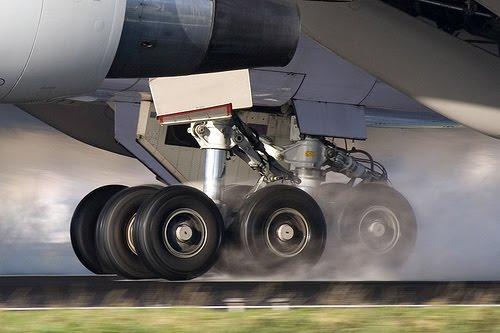Aircraft Brake System Market: Emerging Trends in Carbon-Carbon Brakes and Electrification of Aircraft

The global aircraft brake system market is undergoing rapid transformation, driven by advancements in technology, increasing air traffic, and a growing focus on fuel efficiency and sustainability. Aircraft brake systems are crucial components in the safe operation of any aircraft, responsible for slowing down or stopping the aircraft after landing. As the aviation industry continues to evolve, several emerging trends are shaping the aircraft brake system market, from innovations in materials and design to the integration of smart technologies. This article highlights the key emerging trends that are influencing the aircraft brake system market.
1. Adoption of Carbon-Carbon Brakes
One of the most significant trends in the aircraft brake system market is the increasing adoption of carbon-carbon brakes. Carbon-carbon brakes are known for their high performance, low weight, and ability to withstand high temperatures. These brakes are made from a composite material that combines carbon and graphite, offering exceptional heat resistance and a longer lifespan compared to traditional metal-based brakes. Carbon-carbon brakes are increasingly being used in commercial and military aircraft because they provide better performance in high-speed landings, reduce maintenance costs, and improve fuel efficiency due to their lightweight nature.
As passenger and freight air traffic grows, airlines are seeking ways to reduce operating costs, and carbon-carbon brakes play a key role in that effort. Additionally, carbon-carbon brakes have become a standard in high-end, larger commercial aircraft models such as the Boeing 787 and Airbus A350, further driving the market's expansion.
2. Growth in Electric and Hybrid Aircraft
Another emerging trend is the rise of electric and hybrid-electric aircraft, which is transforming the aircraft brake system landscape. These new aircraft models require specific brake system designs to accommodate the unique characteristics of electric propulsion systems. As electric motors are used to power aircraft, there is a reduced reliance on traditional jet engines, which affects the way braking systems need to function.
For instance, the brakes in electric and hybrid-electric aircraft must handle unique challenges, such as the need to manage lower levels of power, different weight distribution, and energy regeneration. Regenerative braking, which is more commonly used in electric vehicles, is also being explored for aircraft. This braking system allows the aircraft to convert kinetic energy during braking into electrical energy, which can be stored and used to power the aircraft’s systems. This can significantly improve fuel efficiency and reduce carbon emissions.
3. Integration of Smart Technologies
The integration of smart technologies is revolutionizing aircraft brake systems, enhancing their performance, reliability, and safety. Advanced sensors and monitoring systems are increasingly being incorporated into braking systems to provide real-time data about brake wear, performance, and condition. These systems use data analytics and artificial intelligence (AI) to predict maintenance needs, optimize performance, and detect potential failures before they occur.
For example, many modern aircraft now feature Brake Temperature Monitoring Systems (BTMS) that provide real-time data about brake heat levels, helping pilots and maintenance crews ensure that brakes operate within safe temperature ranges. In addition to improving safety, these smart systems can reduce the frequency of unscheduled maintenance, leading to cost savings for airlines.
The implementation of predictive maintenance, powered by AI and machine learning, is another aspect of this trend. By continuously analyzing data from brake systems, operators can predict when components are likely to wear out, enabling them to schedule maintenance more effectively, reduce downtime, and increase the lifespan of brake components.
4. Emphasis on Weight Reduction
Weight reduction remains a crucial focus in the aircraft industry, with aircraft manufacturers and suppliers constantly seeking ways to make aircraft lighter without compromising safety or performance. In the brake system market, this has led to a shift toward using lighter materials, such as advanced composites and high-strength alloys, in the construction of brake components.
By reducing the weight of brake systems, aircraft can achieve better fuel efficiency, which is critical for airlines aiming to reduce operating costs and lower carbon emissions. Lightweight brakes also reduce the overall weight of the aircraft, allowing for higher payloads and longer flight ranges, which is particularly beneficial for commercial airliners and cargo aircraft.
5. Regulatory Pressures and Environmental Concerns
Environmental concerns are increasingly influencing the design and operation of aircraft brake systems. Governments and aviation authorities are introducing more stringent regulations aimed at reducing the environmental impact of aviation. For example, there are increasing requirements for airlines to lower their carbon emissions and improve fuel efficiency, both of which have direct implications for aircraft brake systems.
Brake manufacturers are responding to these regulatory pressures by developing more environmentally friendly materials and designs. Carbon brake systems, for instance, are not only lighter and more durable but also generate less particulate matter compared to traditional metal-based systems, which can be harmful to the environment. Additionally, the trend toward regenerative braking and energy-efficient systems reflects the aviation industry's commitment to sustainability.
Conclusion
The aircraft brake system market is experiencing significant changes driven by technological advancements, sustainability concerns, and evolving industry demands. Key trends such as the adoption of carbon-carbon brakes, the rise of electric and hybrid-electric aircraft, the integration of smart technologies, a focus on weight reduction, and the increasing emphasis on environmental sustainability are shaping the future of aircraft braking systems.
- Art
- Causes
- Crafts
- Dance
- Drinks
- Film
- Fitness
- Food
- Games
- Gardening
- Health
- Home
- Literature
- Music
- Networking
- Other
- Party
- Religion
- Shopping
- Sports
- Theater
- Wellness


